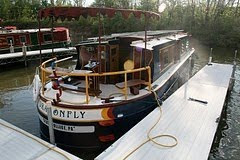 |
| What you see on screen: Little colored marks along the edge of the white channel. |
On Sunday, Al Miles, Portsmouth-area businessman and boater, drove us to a grocery store so we could re-supply, then took us to a marina restaurant so we could spread out charts and pore over them together. Thanks, Al!
 |
| What you see in the real world: "aids to navigation." |
We were set for groceries but turns out Bill works for the Coast Guard. He generously organized an insider's tour of the Portsmouth Station.
We were excited. Only Monday we'd been boarded by the Coast Guard. Now, we would get to inspect them!
 |
| What SlowBoat wants to be when she grows up: A U.S. Coast Guard "Fast Attack Tug." (Top speed 6 knots) |
 |
| Long, low, shallow-draft, made of steel . . . Kennebec is our kind of boat |
"We inspected these two vessels last night," Mathus said, pointing to some dots. Why? "Let's just say they were of interest." The Coast Guard is both a branch of the U.S. Military and part of Homeland Security. A yellow strobe flashed overhead, warning the staff to be careful what they discussed with civilians on deck.
 |
| On top of all the technology, the crew of the Kennebec ALSO have to be ecologists. No buoy repair while birds are nesting. |
Next stop: The inland construction tender Kennebec. Translation: This is the boat that puts in place and maintains "aids to navigation," the red and green buoys and daymarks that have allowed us to make this trip without getting hopelessly lost.
At 160 feet long and 32 feet wide, CGC Kennebec carries a crew of 17 and roams the region from Washington, DC, down the Chesapeake to Roanoke Island, North Carolina. We were amazed to learn the vessel carries no anchor. Instead, she "spuds down." Translation: The Kennebec comes equipped with four steel pilings (spuds) and the power to drive them straight down into the sea floor, transforming itself from a free-floating boat to a kind of sturdy wharf.
Commanding officer Gale Howerton took us up to the bridge for a view of the Kennebec's other striking feature, its 70-foot construction crane--very handy for hoisting multi-ton steel buoys into place.
 |
| The technology for keeping buoys and daymarks lighted keeps advancing. |
We wrapped up our tour by climbing aboard a "25." Translation: The workhorse boats of the Coast Guard, those distinctive, Boston-Whaler style boats (25 feet long) with the bright orange, bulbous, Zodiac-like fenders that you see patrolling harbors. They're the kind of boat our recent boarding party was operating. (Yes, it was cool to actually be inside one. Much like a small plane).
We talked with the young Coast Guard officer who showed us this boat. "What makes people join the Coast Guard?" we wondered. We assumed it was the boating--the chance to make hanging out on boats part of your job. But no, she said. "It's people who feel a sense of duty, they want to serve their country, but they're less interested in combat operations and more interested in helping people," she said.
It's the Brotherhood of the Boaters--but with the supercoolest technology.





How interesting this side-trip must have been!! Also, the Williamsburg day. I have longed to return to this historic place. I was there once when I was a very young girl, and have wanted to go back ever since. Oh, well, maybe someday. Stay in the area as long as possible, since Spring has yet to arrive up north. 4-8 inches of snow expected tonight in the Pocono's. Life is good, sometimes.
ReplyDelete